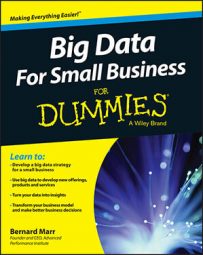How does the Internet of Things relate to big data? The Internet of Things describes the fact that many everyday objects, from diapers to self-driving cars, have (or soon will have) the ability to send and receive data via the Internet. You can find out more about the Internet of Things and the explosion of data in Big Data for Small Business For Dummies. Much of this big data is driven by sensor technology, as well as the increasing connectivity of, well, just about everything in our world.
This huge increase in data gives you the ability to create a smarter world where buildings sense and predict temperatures outside and adjust heating or air conditioning systems inside, where cars drive themselves and where your baby’s diaper tweets you when it needs changing. A futuristic vision? No, all of these things are already possible today.
Here are a few more very real examples of what the Internet of Things is already doing:
Wearable devices such as the Fitbit and UP fitness trackers collect data on how many steps you take, how well you sleep, how many calories you consume and much more. The next big push in wearable technology is in smart watches – Apple’s version was launched in 2015. These watches collect data on almost anything – your geographical location, your speed or your body functions – and this data can be synced to phones or tablets and analysed in apps.
Sensors are everywhere. The oceans are full of sensors that track sea temperature and currents. A number of companies put sensors into farmland to track soil health and predict the right level of fertilizers required to obtain an optimal crop. Your toothbrush can even sense how well you’re brushing and send the analysis to your smartphone so you can improve your brushing technique!
There are security alarms that connect to the Internet and alert you about any intruder. Bathroom scales are connected to the Internet and not only monitor weight, body mass index and heart rate, but also the air quality in the house. There are light bulbs that link to wireless networks, which allows you to control them with an iPhone. There are also sensors in gardens and indoor plants that send a message to a phone when they need watering.
There are endless opportunities for businesses, science and governments to exploit this new data tidal wave. Just imagine what will happen when you connect all these devices in even smarter ways – when your refrigerator knows what items are past their use-by date and re-orders them for the next shop; when your smart watch makes an appointment with your doctor because it detected some abnormalities; when buses wait for a delayed train to arrive; or, when your alarm automatically adjusts its wake-up time because your early morning appointment cancelled overnight.

